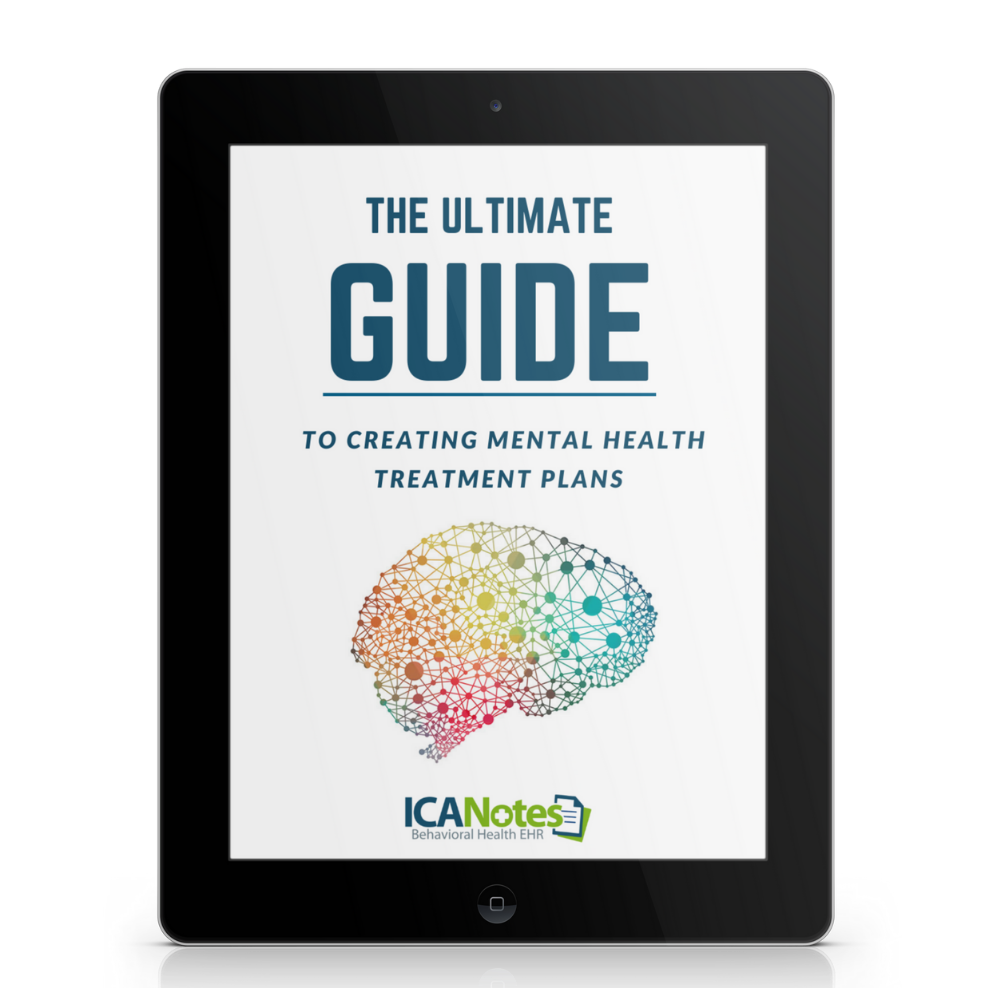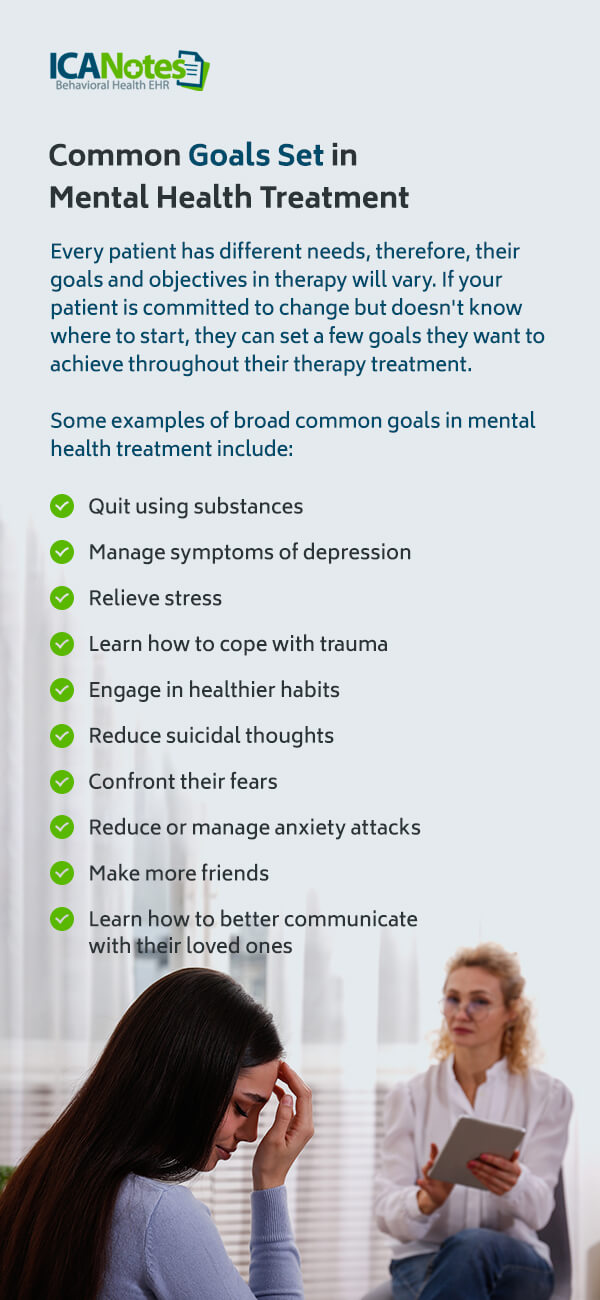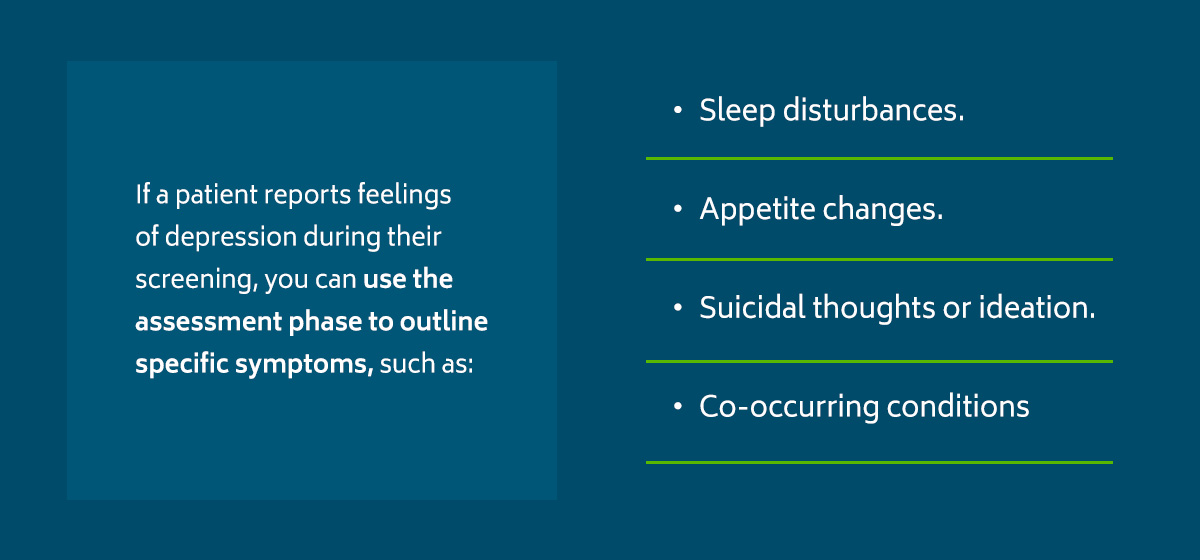
Mental health treatment plans are individualized roadmaps that behavioral health professionals use to help patients focus on meeting their goals. These plans help clinicians like you stay organized and record patient progress during treatment. An effective treatment plan empowers behavioral health counselors to deliver comprehensive care to meet each patient's needs.
In addition, mental health treatment plans make it easier for therapists to monitor a patient's growth and healing between sessions to determine if they need to make therapeutic adjustments. While creating a treatment plan isn't a requirement for all mental health professionals, it leads to more effective outcomes and benefits both the provider and the patient.
Learn everything you need to know about mental health treatment plans and how they can transform your normal therapeutic procedures.
What Is a Mental Health Treatment Plan?
A mental health treatment plan is a document that contains specific details relating to an individual patient and their treatment. Treatment plans are an effective tool for improving patient engagement in their treatment because they outline their current struggles and how they will overcome them with a therapist's help. While treatment plans vary depending on a patient's needs, they typically follow the same general format, which includes:
- Their personal, demographic and insurance information.
- Their psychological history, if necessary.
- Their current mental health diagnosis or condition.
- A timeline to monitor their progress.
- High-priority goals to achieve during treatment.
- Clear and measurable objectives that are relevant to their goals

What Is the Purpose of a Treatment Plan?
A mental health treatment plan, sometimes called a therapy or psychotherapy treatment plan, aims to help patients achieve their goals by relieving symptoms and helping them overcome the challenges they're experiencing in their initial treatment session. Treatment plans also help behavioral health professionals, like counselors, monitor a patient's progress and determine if treatment adjustments are necessary.
Without a treatment plan, it may be difficult for patients to visualize the path they need to take to reduce their negative thinking patterns or improve their habitual behaviors. Lacking this structure can make it more difficult for patients to set and accomplish their therapy goals. Goal-setting is a significant treatment plan component that contributes to the effectiveness of a mental health intervention. Setting goals in a treatment plan helps patients:
- Feel motivated.
- Focus their efforts.
- Boost their self-esteem.
- Engage with their treatment.
- Feel a sense of accomplishment.
- Concentrate on their priorities.
- Avoid distraction.
Treatment plans also help therapists and behavioral health clinicians with documentation. Treatment plans contain essential information about a patient's progress in a clear and organized format, with measurable goals and target completion dates. With this information readily available, documenting progress toward goals in each individual session note becomes an easier part of the job.
Write Better Treatment Plans - Free Guide

Download this free guide to learn everything you need to know to write better treatment plans
Mental Health Treatment Plan Goals and Objectives
Using a treatment plan is an effective way for therapists to engage patients in their treatment and allow them to work together to create goals and objectives that align with their shared vision. Treatment plan goals can include general purposes and intentions the patient wishes to accomplish.
Examples of Goals to Include
Goals tend to be broad statements the patient wants to achieve by the end of their treatment.
Consider these examples:
- Managing negative emotions and feelings without turning to substances
- Learning interpersonal skills to communicate positively with others
- Learning healthy emotional management skills
- Establishing coping strategies for stress
- Reducing the frequency and severity of mood swings
- Managing hallucinations or delusions
- Improving self-care behaviors and habits
- Boosting self-esteem
Examples of Objectives to Include
Think of an objective as a rung on a ladder that gets the patient closer to their goals. Objectives tend to be smaller, specific tasks or skills a patient must accomplish to reach their larger treatment goals. These tasks should be clear and measurable, giving the patient direction toward their goals. For example, you may record objectives like:
- Attending substance abuse meetings to help with sobriety.
- Keeping a journal of daily communication to help develop effective communication skills.
- Taking antidepressant medication and attending therapy to reduce depression symptoms.
- Initiating conversation in social situations.
- Establishing a daily routine.
- Incorporating physical activity and proper nutrition.
- Following a consistent sleeping schedule.
Simply said, an objective is a specific way to reach a goal.
Common Goals Set in Mental Health Treatment
Every patient has different needs, so their goals and objectives in therapy will vary. If your patient is committed to change but doesn't know where to start, they can set a few goals they want to achieve throughout their therapy treatment.
A few goals to consider during mental health treatment include:
- Avoiding substance use.
- Building a supportive group of loved ones.
- Learning better communication skills.
- Confronting fears and anxieties.
- Managing depression symptoms.
- Overcoming symptoms of trauma.
- Developing stress relief techniques.
- Managing and reducing anxiety attacks.
- Reducing thoughts of suicide.
Once these goals are set, you and your patient can work on specific actions — or objectives — that can back up these overarching goals.
For instance, if a patient has extreme anxiety when leaving the house, they could set a goal of walking 30 steps outside their front door. Eventually, they can work up to going to the grocery store or practicing daily walks around the neighborhood. If your patient has difficulty interacting with others in a social setting, they may set a goal of talking to one new person each week or joining a club to practice conversing with others regularly.

How to Write a Treatment Plan for Mental Health
Before creating a treatment plan, the first step is to gather information in a screening. The second step is to conduct a mental health assessment. During the screening of a new client, they should provide you with a brief overview of the presenting issue or issues that motivated them to seek therapy. Once you have a general understanding of their condition and needs, you can move on to the assessment step.
During the assessment stage, you'll gain a more detailed view of the nature and severity of your patient's presenting problem. For example, if a patient reports feelings of depression during their screening, you can use the assessment phase to outline specific symptoms, such as:
- Sleep disturbances.
- Appetite changes.
- Suicidal thoughts or ideation.
- Co-occurring conditions like anxiety or substance abuse.

After a detailed assessment and discussion with your client, you'll be ready to draft a treatment plan tailored to their specific needs. At this time, you'll also need to identify and discuss possible goals with your client. Consider this last step a collaborative process — ensure that the goals outlined in the treatment plan are agreeable and realistic.
For example, if your patient reports severe social anxiety, a reasonable goal might be to manage physical symptoms of anxiety, such as a rapid heartbeat or shaking hands. This is an achievable starting point that will likely make your client feel more motivated to follow through with their therapeutic assignments.
Once you've created your treatment plan, you and your client must both sign the document. This demonstrates that you and your client agree on the treatment plan, including its goals and objectives. Keep in mind that treatment planning, just like therapy, is an ongoing process. You'll review and revise the treatment plan as needed because nothing is written in stone. A mental health treatment plan template will help you stay organized, but its information is unique to the client and open to changes.
Therapy Treatment Plan Template
Treatment plans are designed to be simple but particular to each individual and their needs. While every treatment plan will vary slightly depending on the patient's reason for seeking mental health treatment, a treatment plan template or document will generally contain the same categories, which include:
- Patient information: The first thing counselors should include in any treatment plan or document is any required patient information, such as their name, demographic details, insurance details emergency contacts and other relevant information.
- Diagnostic summary: The therapist should then include details about the patient's current diagnosis, past diagnoses and treatment history. Include information about the patient's current mental state or condition, if possible.
- Problems and goals: The treatment plan should include measurable objectives, issues and goals that allow the counselor and patient to track progress. Each of these categories should include a time frame or deadline for completion. Aim for at least three or four goals.
- Signatures: In the final part of the treatment plan, the provider and patient must sign and date the document. Having the patient sign the form shows they know their treatment timeline and goals and that they participated in and agreed with the content.
Mental Health Treatment Plan Checklist

Your treatment plans should be thorough while only including relevant details. For many behavioral health professionals, it can be challenging to determine what details to include in a treatment plan. To avoid missing any crucial details, use this checklist as a helpful reminder:
- Issues: Do the issues reflect the six problem domains— medical status, employment, substance abuse, legal status, family or social status and psychiatric status? Are issues written in behavioral terms and a non-judgmental manner? Are they prioritized?
- Goals: Do the goals address the listed issues? Are they attainable during treatment? Does the patient understand the goals as written? Does the client seem ready to change and accomplish the goals?
- Objectives: Do the objectives address the goals? Are the objectives measurable and specific? Can the client take the time or steps necessary to complete objectives? Is there a time frame for the objectives? Are they realistic for the patient's current situation? Does the client understand what is expected of them?
- Interventions: How will the counselor help the patient achieve their goals? What specific techniques and exercises align with the patient's emotional and physical circumstances? Is the patient ready to engage in the necessary steps toward their goals? Are they willing to accept and participate in the interventions and treatment options?
- Treatment modality: Does every goal have an applicable treatment modality? Does the treatment plan outline a frequency of sessions for reaching these goals and an anticipated completion date that can be measured?
- General: Is the treatment plan customized to suit the patient based on their unique skills, goals, lifestyle, educational background, culture and socioeconomic status? Are their strengths incorporated into the treatment plan? Has the patient participated in developing the plan? Does the plan contain the date and the patient's and counselor's signatures?
Mental Health Treatment Plan Insurance Requirements

As a behavioral health clinician, you have many clients to see and many administrative tasks to attend to. However, including missing or inaccurate information in your treatment plan or therapy documentation can result in under-coded notes or rejected insurance claims. Many therapists provide a patient's treatment plan as concrete justification for each session when sending a bill to an insurance company, so it's important to check all your boxes.
Though every insurance company has varying requirements, here's a brief overview of the general factors that will display your patient's medical need for treatment:
- A current diagnosis/comorbid diagnoses
- Medications and dosages
- Severity and duration of symptoms
- Problems with daily functioning
- Risk factors, if any
- Treatment goals
- Objectives for reducing specific symptoms or behaviors
- Measurable outcomes
- Frequency of sessions
- Therapeutic interventions and modalities
- A timeline for patient progress
Here's another tip — when discussing your client's therapy goals, be sure to note how they will address specific medical symptoms rather than just achieving self-improvement. For instance, instead of stating that your client's goal is to improve their agoraphobia, you might say the goal is to decrease dizziness, fast heart rate and choking sensations when in an unfamiliar environment. Then, outline how the therapy treatment plan will help your patient achieve this.
Insurance companies look for evidence that treatment is a "medical necessity." If you have these elements included in your treatment plan, there's a good chance you've covered all your bases and will demonstrate that your client still requires treatment.
Determining Factors in Creating a Tailored Mental Health Treatment Plan

Every patient has unique experiences, symptoms and needs regardless of their mental health diagnosis. A mental health treatment plan can help you stay organized and on track with your patients' goals and care needs.
Goals and objectives are a pivotal aspect of your documentation and care, so it's important to consider certain factors that may impact your treatment plan, including your patient's:
- Current mental health condition: Your patient's current state of mental health can significantly impact the therapy treatment plan. Be sure to assess the nature, duration and severity of their symptoms or presenting problem.
- Strengths and resources: Does your patient have family members and friends to lean on for social support during treatment? Do their strengths include resilience to challenging life events or coping skills? If so, these resources can be leveraged to help them reach their goals.
- Readiness for change: Assessing your patient's readiness to change can improve the chances of their treatment being successful. Determine their readiness to change with the transtheoretical model to gain a better understanding of your patient's stage of intentional change. This model features five stages of change — precontemplation, contemplation, preparation, action and maintenance.
- Cultural and social factors: An individual's cultural and community experience should inform their goals and objectives. These factors, as well as societal context, can impact the patient's willingness to engage in treatment. All mental health treatment plans should be culturally sensitive and appropriate.
- Need for holistic care: While addressing symptoms is a priority, it's important to consider a comprehensive approach to your treatment plan. For example, you might incorporate all aspects of the patient's well-being, including their physical, social, emotional and spiritual health, into their individualized treatment plan.
Using these factors as a guide can help you tailor your mental health treatment plan to their unique needs and avoid making generic goals and objectives.
Mental Health Treatment Plan Tips

There are no set rules for developing a treatment plan for your patient because every plan is unique. Typically, you'll start with a mental health treatment plan template and tweak it as necessary for your patient. Creating a mental health treatment plan can feel daunting, so here are a few best practices to help you through setting goals and planning.
1. Measure Success
To evaluate the effectiveness of the treatment plan, you need to keep a score of how the patient is doing. You can monitor their progress more effectively by asking them to keep track of their thoughts, feelings and behaviors in a journal or document. Self-reports can give you a better glimpse of your patient's state of mind between sessions and over time.
You should also note observations and signs of improvement or decline during your sessions. For example, you may notice your patient has more relaxed body language each time you see them, indicating signs of improvement. As you measure your patient's success, you'll determine whether your treatment plan is effective or needs adjustments.
2. Set SMART Goals
Your patients may become overwhelmed if you set goals and objectives that are too challenging or far outside their comfort zone. For treatment to be effective, yet motivating for your patients, work with them to set goals they can actually reach. To do this, use SMART goals as a template for creating clear, realistic goals that guide them toward their intended accomplishments. SMART stands for the following:
- Specific: Goals should be clear and explicit. Set goals with plain language and strong verbs so your patient knows exactly what to do. Patients with specific goals will be able to complete them more effectively than goals that are too general or vague.
- Measurable: Goals with specific dates, times or amounts are easier to track and monitor. For instance, goals like completing an assigned task within two weeks or reducing the number of times they use substances within a month are easy to monitor.
- Attainable: Patients should be able to realistically meet their goals. This may require thorough conversations with your patient to determine what limitations may hold them back from certain goals. They will likely feel discouraged and defeated if their goals are too difficult or unreasonable from the start.
- Relevant: Goals and objectives should relate to the patient's individual needs outlined in the treatment plan. Consider what goals would help a patient reach their expected treatment outcomes and how they're relevant to the patient's progress.
- Time-bound: Deadlines make it easier for patients to feel motivated. These can be short- or long-term goals as long as they have a specific end date. For instance, a counselor may ask a patient to choose and join a community event or club by the end of the month to help with their anxiety. Time-bound goals also make measuring progress easier and hold the patient to the goal rather than seeming never-ending.
3. Set Goals That Motivate
Patients are more likely to complete objectives and work toward reaching a goal if the goal is personally important to them. Help your patients set goals that they have personal stakes in so they're motivated to make it happen. If a goal does not add value or meaning to their life, they will not have the motivation to work through objectives.
Ask patients to discuss goals that are meaninful to them. Make sure the goals are in order of importance so patients can focus on their priorities.
4. Use the Right Language

Adequately describing your patients' conditions and progress is essential to creating an effective treatment plan. Therapists often use various power phrases and words to describe their patients, though it's important to consider the emotion behind your word choice. For example, “obsessive” and “all-consuming” can be used synonymously in many cases, though the two words carry different connotations. Despite having the same meaning, describing someone or something as “obsessive” sounds more negative.
As a therapist, it's essential to maintain unbiased diagnoses and treatment plans. Using the right language can make a big difference in how you perceive a patient and how they perceive themselves. When creating your mental health treatment plans and other patient notes, consider your word choice and where you may use synonyms to elicit different emotions with your words.
5. Collaborate With Patients
A client-centered approach to treatment — one that involves your patients in the treatment plan process — is important for making them feel like an active participant in their own treatment. Let your patient know that you're on the same team and will use the treatment plan as a roadmap to their improvement or recovery. You might start by gathering information about their hopes, aspirations, concerns and expectations for treatment.
When you invite patients to collaborate with you in creating the treatment plan, you demonstrate that you value their thoughts and opinions. Seek their input throughout the treatment process to better understand them and their struggles.
Trust is also important between therapists and patients, so give your patient time to open up and engage as the treatment plan progresses. Giving them a say can prompt them to feel seen and understood, which can promote trust. Be sure to always consider their comfort level and preferences with therapy procedures or assigned tasks.

6. Leverage Templates
Proper documentation, organization and maintenance of behavioral health records are essential for ensuring accuracy, protecting patient confidentiality, providing comprehensive care and maximizing reimbursement. However, documenting notes by hand can take up a significant amount of your time, potentially leaving you stressed or frustrated. If you have a full caseload, capturing the same necessary details can feel demanding and repetitive.
With intuitive templates, you can benefit from effective treatment planning in much less time. Prebuilt note templates for all behavioral health disciplines and settings enable you to customize a treatment plan to your individual patient's needs. In addition to treatment plans, these templates can produce comprehensive initial assessments, progress notes and discharge summaries for a holistic view of care.
How a Mental Health Treatment Plan Complements Other Therapy Notes
Treatment plans help the patient and serve the entire behavioral health team. These documents promote good communication between staff members and provide the documentation necessary for billing. As part of a patient's medical health records, treatment plans also help facilities comply with federal and state laws. Let's look at a few ways mental health treatment plans assist with recordkeeping.
1. Psychiatric Evaluation
A psychiatric evaluation involves using tools to measure and observe a client's behavior. A psychologist evaluates clients, observing how they interact with others, think and act. Using the evaluation, you will determine a diagnosis. Once a diagnosis is made, you should develop a treatment plan that complements the evaluation. This treatment plan should directly address the concerns found during the evaluation and how you'll work with the patient to treat the issues.
A treatment plan for psychiatric evaluation helps organize this information in one neat document. The treatment plan also allows for quick reference of the initial evaluation when staff members or counselors need to revisit the evaluation in the future. Chances are that you'd be making a treatment plan for your psychiatric evaluation patients regardless, so using a plan template keeps your notes consistent, concise and well-organized.

2. Progress Notes
Treatment plans and progress notes tend to go hand in hand because progress notes need to incorporate one or more treatment objectives. Progress notes are essential for communicating patient care and getting reimbursed for services. Therapists and counselors often see many patients per week, making it challenging to remember exactly where they left off with each patient as they begin a treatment session.
Progress notes enable therapists to monitor where patients are on the path to their goals and what objectives they still need to tackle. A treatment plan helps staff meet progress note requirements and track patient progress. Progress notes typically include:
- The treatment plan.
- Any changes in the client's condition.
- Descriptions of a client's response to treatment.
- The outcome of treatment.
3. Discharge Summary
When patients are ready to leave a treatment program, a discharge summary is needed to document how they completed treatment and their plan for continuing care. A treatment plan can guide the writing process when it's time to produce an accurate, detailed mental health discharge plan. With a clear treatment plan, therapists and counselors can more easily describe all treatments provided, summarize their care and how the patient's condition has improved and explain why they agree with the discharge.
Because some patients undergo therapy and mental health treatment for months or years, a treatment plan acts as a visual timeline for therapists to review and see how the patient has progressed since their initial visit. Here are some examples of what a counselor might include in a discharge summary:
- The patient reports their suicidal feelings have been relieved.
- The patient expressed a better understanding of how to cope with their depression.
- The patient's mood shows no signs of depression or elevation.
- The patient presents no signs of anxiety.
- The patient reports feeling confident in their ability to communicate with others.
- The patient's behavior is appropriate, showing no signs of delusions or hallucinations.
Why Trust Our Expertise for Creating Treatment Plans?
Improving efficiency and reducing administrative burden as a behavioral health provider has never been more important. At ICANotes, we've developed software specifically designed to improve the content, speed and legibility of your legal documentation. As the premier electronic health record (EHR) software provider for behavioral health, we can help you continue to provide high-level services without compromising quality.
You can trust that our behavioral health EHR meets your needs as a clinician — because it was developed by clinicians! Our leadership team has extensive experience in the behavioral and mental health fields, which directly informed the features and functionality of ICANotes. Our goal has always been to help clinicians address common practice challenges with reliable, secure technology.
Our customer reviews reflect the success of our behavioral health EHR, with professionals noting how much faster and easier it is for them to complete documentation. Our customers also report their satisfaction with our technical support and the ability of our highly intuitive software to streamline behavioral and mental health care.
Create a Mental Health Treatment Plan With ICANotes
Behavioral health EHR software allows medical professionals to digitally store vital documents, such as treatment plans, evaluations and discharge summaries, in an organized, user-friendly format. ICANotes is EHR software designed specifically for the behavioral health field. With ICANotes, you can easily and quickly create unique patient treatment plans.
Proper documentation does not need to be a stressful, time-consuming part of the job. ICANotes Behavioral Health EHR offers benefits such as:
Start Your Free Trial Today
